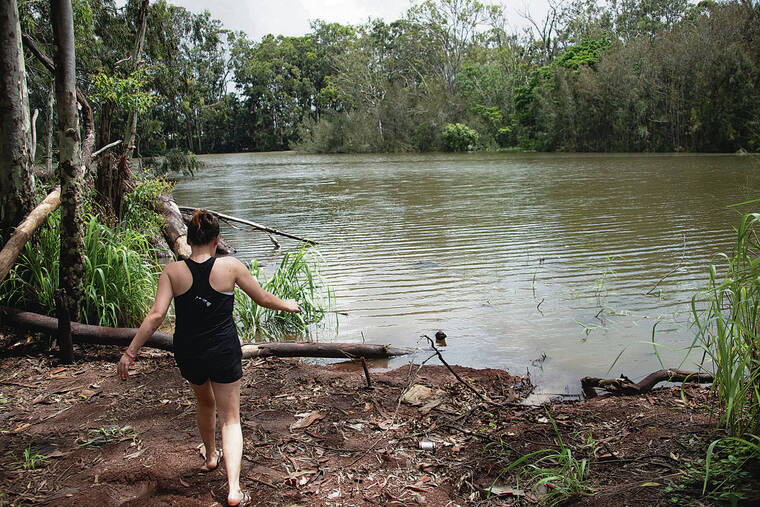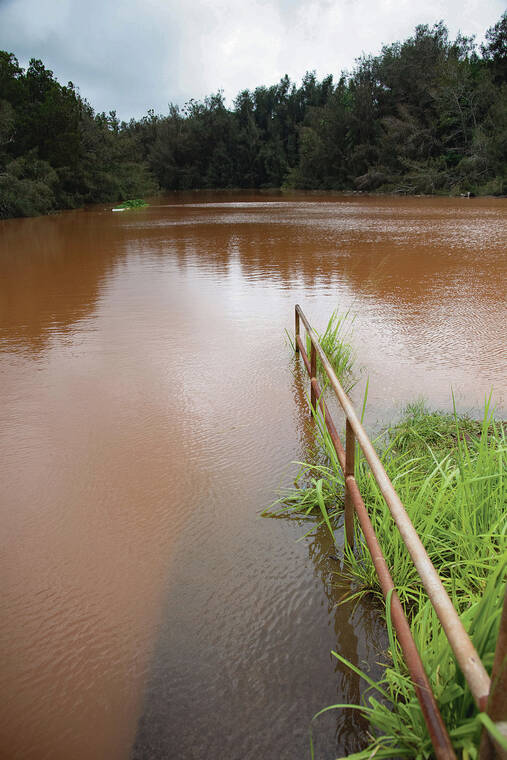As the Kona-low system that pummeled Oahu on Thursday makes its way westward, officials on Oahu continue to monitor reservoirs that filled to the brim while state officials prepare for potential flooding on Kauai.
Many of the dams across Hawaii that keep water in reservoirs are in need of serious maintenance, with only one of the 13 dams on Oahu — the Kaneohe Dam — considered to be in “satisfactory” condition.
But on Thursday night Honolulu Emergency Management Director Hiro Toiya said during an online news conference that of the island’s 10 “high-risk” dams, Wahiawa was the only one that was a concern as downpours drenched the island.
By 10:15 a.m. Friday, the National Weather Service said, the Wahiawa Reservoir was just above 82 feet — 2 feet short of the “flood stage,” which would have prompted authorities to call for evacuations of nearby areas. The maximum level of the dam is 88 feet.
“The City is actively monitoring the Wahiawa reservoir and working with the owners of the dam to ensure the safety and well-being of all residents in the area and downstream,” said Honolulu Department of Transportation Services spokesman Travis Ota in an email. “With the rains heading more west, the dam has been lowering and is less likely that an evacuation is needed. However, the City has been proactive in ensuring that all steps are active and in place, in the event that an evacuation is needed.”
In a statement, Hawaii Emergency Management Agency Administrator James Barros said the worst of the weather system for Oahu had passed — but said that officials are still watching closely.
“Reservoir levels have risen, and streams have reached their crests, but overall, the threat level has diminished,” said Barros. “The emergency management enterprise have planned for various contingencies and are prepared, though immediate execution of these plans may not be necessary given the current conditions. According to the NWS, the weather system is now moving toward Kauai.”
On March 14, 2006, a torrent of over 300 million gallons of water cut a path of destruction and killed seven people when the Ka Loko Dam on Kauai’s north shore gave way after 40 days of heavy rain. In 2018 about 10,000 Oahu residents were put on alert as rain from Tropical Storm Olivia began to fill Nuuanu Reservoir No. 1 and filled with rainwater to just 1-1/2 feet below its dam’s spillway.
Honolulu Board of Water Supply spokeswoman Kathleen Elliot-Pahinui said the agency was monitoring and pumping at the Nuuanu Reservoir on Friday and that water levels there are “below any action alerts.”
“Water gauges on Oahu indicated increased levels, but the infrastructure, including spillways, has functioned effectively, with the support of the Division of Forestry and Wildlife, the Honolulu Fire Department, and the Department of Transportation,” Barros said Friday. “It is anticipated that the rainfall levels will not be sufficient to alter the current state of readiness on Oahu. Our attention is now shifting to Kauai, which is expected to face the brunt of the weather system over the next 12 hours. Agencies and services are focusing their resources and efforts to prepare for the potential impact on the island.”
The state considers both Nuuanu Reservoir No. 1 and the Wahiawa Dam to be in “poor” condition along with three others. The Wahiawa Reservoir is owned by the Dole Plantation, which has put the infrastructure up for sale after receiving fines for not properly maintaining the dam. Many of the dams across the islands are privately owned, holdovers from the once-thriving sugar plantation era that long defined Hawaii agriculture.
The state is negotiating with Dole to purchase the Wahiawa Dam in an effort to modernize it.
“Throughout this heavy rain event, the City has been consulting with the (Department of Land and Natural Resources) dam safety program, and has been monitoring water gauges at streams and dams across Oahu for any potential threats,” said Ota. “There have been no immediate threats of evacuations for areas around these dams.”




